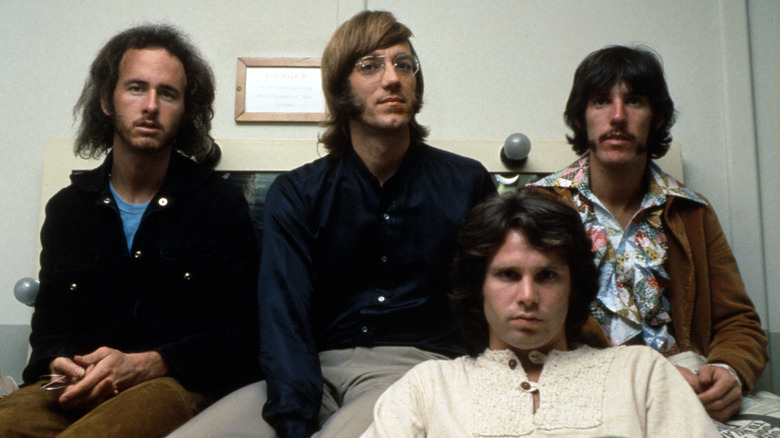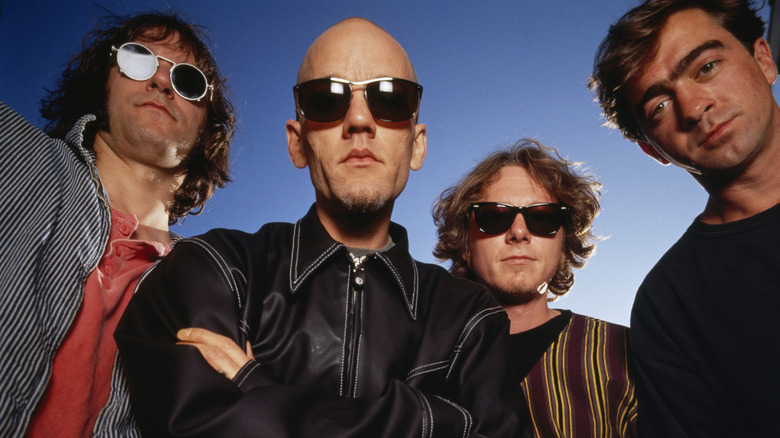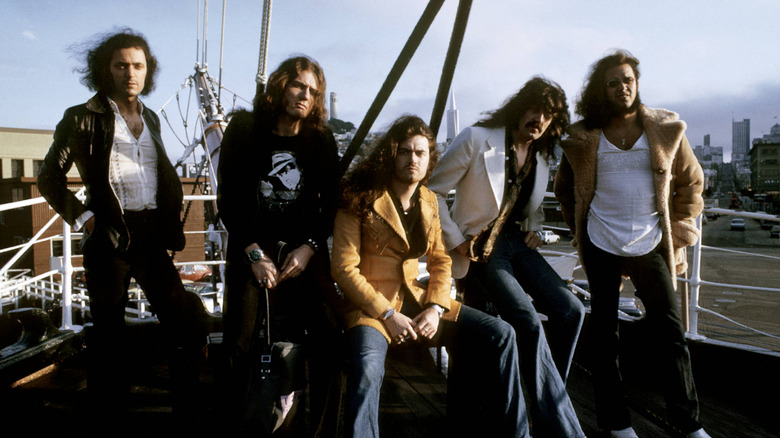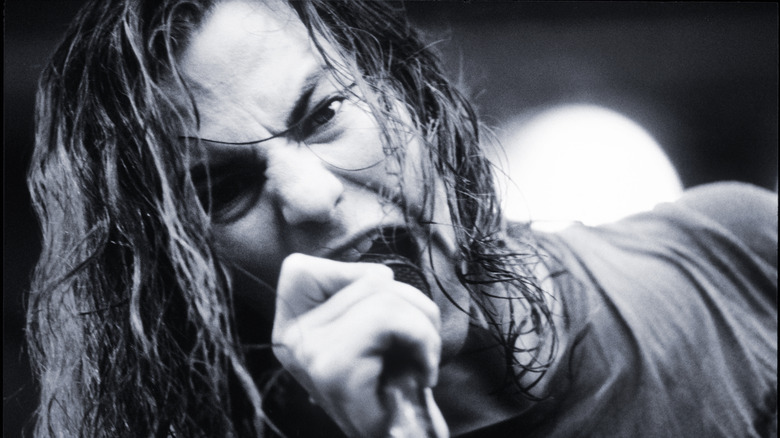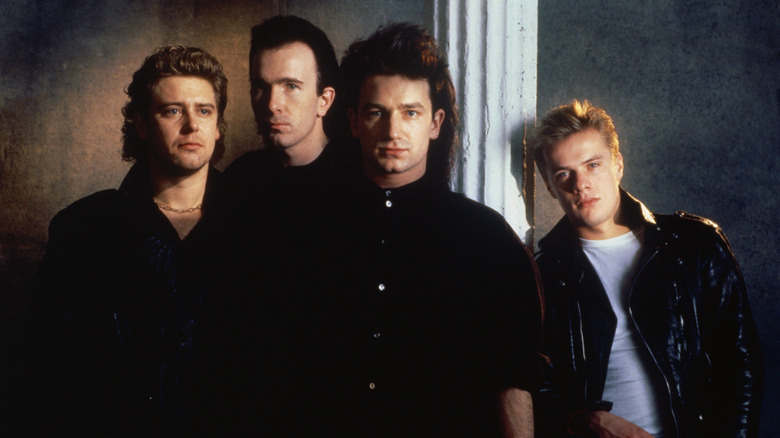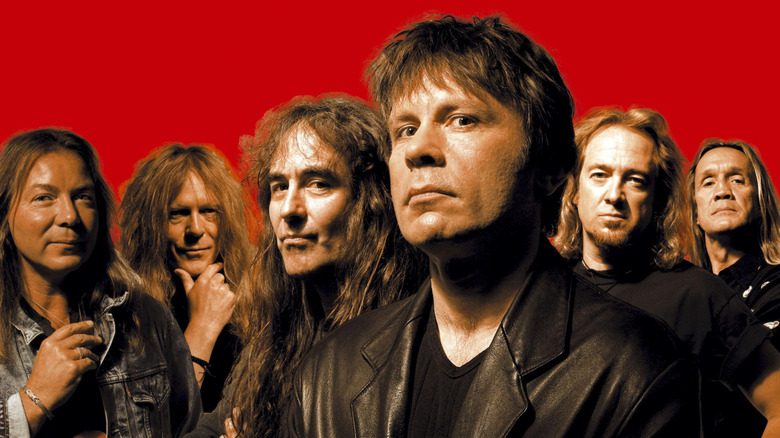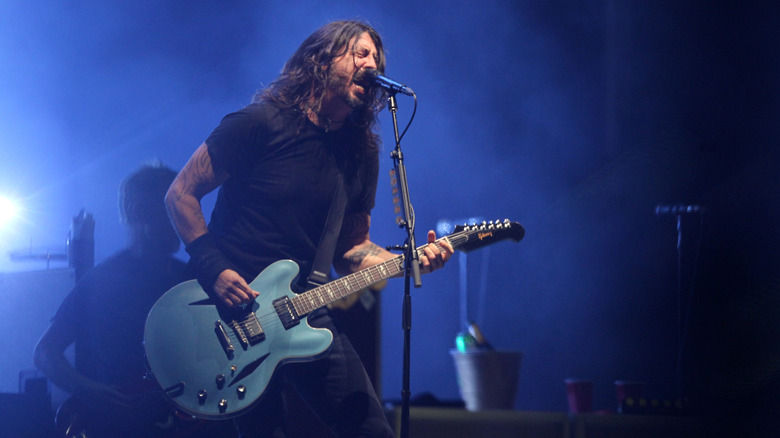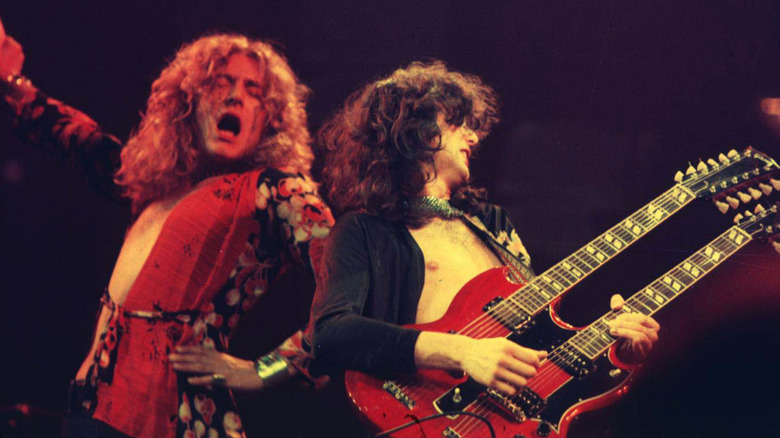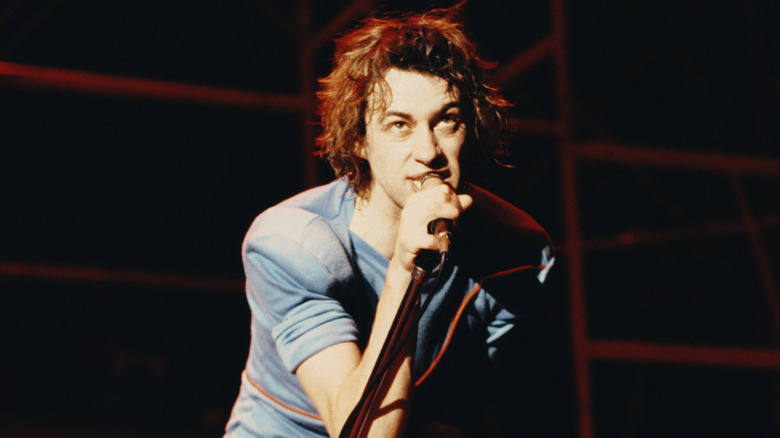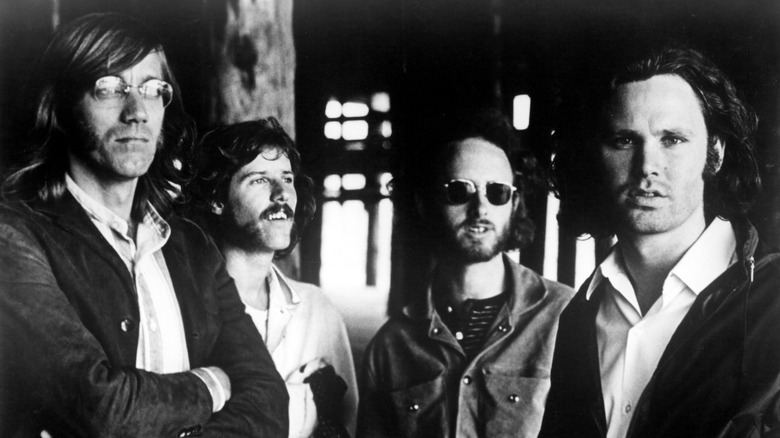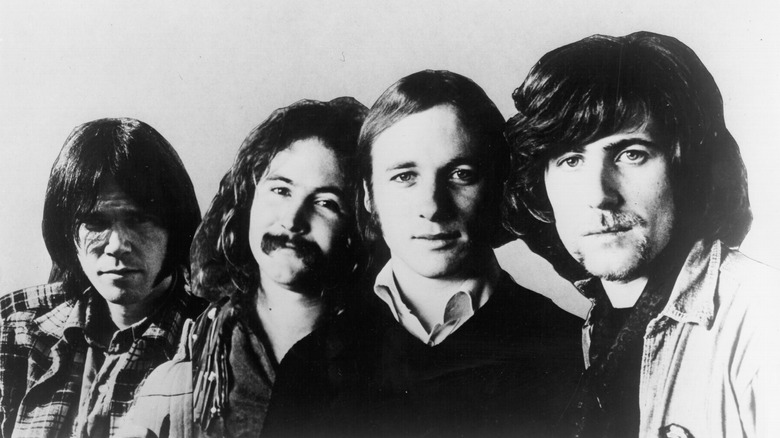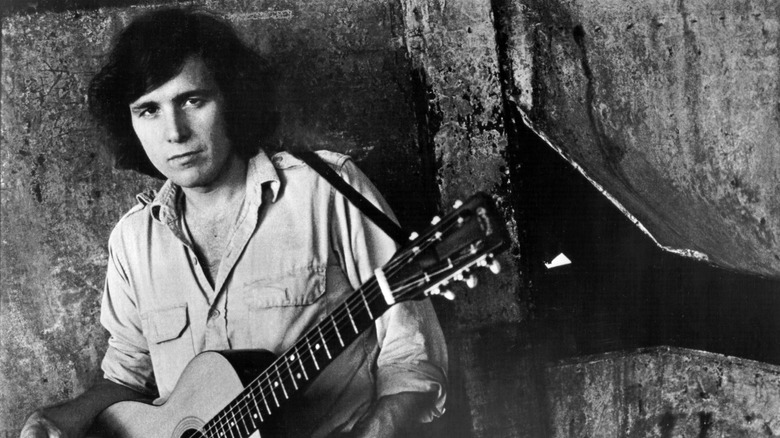Tragic True Stories That Inspired Iconic Rock Songs
When one hears a familiar song repeatedly, especially one that's been around for a while, there's a tendency to sing along somewhat mindlessly, without fully comprehending the meaning underlying the lyrics. So prevalent is this phenomenon that there are numerous hit songs that are actually far darker than fans realize. For example, there's the hidden meaning The Police's "Every Breath You Take," which may outwardly appear to be a tender love song until a closer look at the lyrics reveals it's written from the standpoint of a possessive ex who's become an obsessed stalker. Then there's Foster the People's up-tempo crowd-pleaser "Pumped Up Kicks," which is actually about a disturbed teenager willing to murder people for their shoes, and "99 Red Balloons," Nena's peppy pop hit about the threat of nuclear annihilation during the Cold War.
Meanwhile, there have also been several songs within the rock milieu that were inspired by outright tragedies, ranging from horrific accidents and natural disasters to gruesome murders, terror attacks, and much more. For a deeper dive, read on for a roundup of tragic true stories that inspired iconic rock songs.
REM: Cuyahoga
While these days some may wonder whatever happened to R.E.M., the band once held a solid foothold at the top of the pop charts. Early on, though, R.E.M. was an alt-rock critics' darling before the 1986 album "Lifes Rich Pageant" catapulted the band into the mainstream. Accompanying the album's radio-friendly hits such as "Fall on Me" and "Superman" was "Cuyahoga," a jangly mid-tempo pop-rock number derived from deceivingly dark subject matter. "Let's put our heads together and start a new country up," frontman Michael Stipe sang in the opening line, followed by a chorus of "Cuyahoga, gone."
Boasting imagery of rivers running red and burning waste — and most notably the lyric, "We burned the river down" — the song referred to how Ohio's Cuyahoga River caught on fire in 1969 due to the numerous chemical pollutants that had been carelessly dumped into it by Cleveland-area factories for years.
Interestingly, that wasn't the first time the river had caught on fire; it had done so at least 10 times previously. However, there was a new focus on environmentalism at the time, and news reporting of a heavily polluted river burning in the midst of a major U.S. city on the eve of the 1970s captured far more national attention than earlier Cuyahoga River fires.
Deep Purple: Smoke on the Water
Tragedy is at the heart of the true meaning behind Deep Purple's "Smoke on the Water." The lyrics of the classic stomp-rocker are hardly oblique, recounting how Frank Zappa and the Mothers of Invention were performing at Switzerland's Montreux Casino when the whole place was set ablaze during the band's set. The fire was reportedly started when a concert-goer fired a flare gun into the air, causing the venue's wooden roof to instantly catch fire. As the opening lyrics stated, "Frank Zappa and the Mothers were at the best place around / But some stupid with a flare gun burned the place to the ground." Claude Nobs, who'd organized the Montreux Jazz Festival, franticly worked with firefighters to safely usher fans out of harm's way, as recounted in the subsequent verse, "Funky Claude was running in and out, yeah / Pulling kids out the ground." Thankfully, there were no fatalities, although the casino did, as the song stated, burn to the ground.
While the members of Deep Purple weren't there to see the fire start, they did witness the thick, black smoke billowing over Geneva's Lac Leman from the safety of their hotel room, an image that gave the song its title and now-iconic chorus. As Zappa recalled in an interview shortly after the fire (via Ultimate Classic Rock), every single piece of the band's equipment was utterly destroyed by the flames — with the exception of a cowbell.
Pearl Jam: Jeremy
Arguably among Pearl Jam's most familiar hits, "Jeremy" sprang from a true tragedy, inspired by the 1991 death of Texas teenager Jeremy Wade Delle. When frontman Eddie Vedder read a newspaper report about how the 15-year-old Delle had died by suicide in his classroom, in front of 30 classmates and his teacher, he felt compelled to tell the boy's story, infusing the song with his own personal memories. "And then when I went to write about it, I thought of actually getting a hold of what the actual person it was written about, but then I thought that would be intruding," he said in a 1991 interview with metal magazine M.E.A.T. (via Billboard). "And I totally related because I had a very similar experience with a kid who I grew with ... He kind of freaked out and brought a gun into class one day. It was geography class and [he] shot up a 1,000-gallon fish tank or something. I was in the hallway and I remember hearing it."
Delle's mother, Wanda Crane, hadn't spoken publicly about her son's death for more than two decades until agreeing to an interview with WFAA in 2018. "That day that he died did not define his life," she said, recalling her son as an exceptionally talented artist. While "Jeremy" is now considered a grunge-era classic, it's enduring popularity and its constant radio airplay became a nightmare for Delle's family and a non-stop reminder of their son's suicide.
If you or someone you know is struggling or in crisis, help is available. Call or text 988 or chat 988lifeline.org
U2: Sunday Bloody Sunday
When U2 unveiled their third album, 1983's "War," the breakout single was "Sunday Bloody Sunday." The Dublin-based band and its primary songwriter — U2 frontman Bono — were inspired by the actual "Bloody Sunday," a notorious incident during the Troubles in Northern Ireland. On that horrific day in 1972, British soldiers fired into a crowd of unarmed, nonviolent protesters in Londonderry, killing 13. In the song, Bono sang of the futility of the seemingly endless cycle of violence that had engulfed the Emerald Isle. "How long?" he asked. "How long must we sing this song?"
The first time the band performed "Sunday Bloody Sunday" live was during a concert in Belfast, and Bono was understandably concerned with how the song would be received in Northern Ireland. "It's one thing to write a song called 'Sunday Bloody Sunday' about the Troubles in Northern Ireland; it's another thing to play it," he said in an interview, via Far Out. "We thought a lot about the song before we played it in Belfast, and Bono told the audience that if they didn't like it, then we'd never play it again," added U2 guitarist The Edge. "Out of the 3,000 people in the hall, about three walked out. I think that says a lot about the audience's trust in us."
Iron Maiden: Empire of the Clouds
Over the course of a career spanning five decades, it's arguable that iconic metal band Iron Maiden's most ambitious effort has been "Empire of the Clouds." The centerpiece of the group's 2015 double album "The Book of Souls," the epic 18-minute track recounts the true story of Britain's R101 airship, a luxurious zeppelin-style craft that set off on its maiden flight on October 4, 1930. Launching from Cardington en route to India, the ship crashed in northern France the following day, engulfing the airship in flames. Forty-eight of the R101's 55 passengers were killed in the disaster.
As Iron Maiden frontman Bruce Dickinson explained in an interview with Audacy, he was struggling to capture the crash sonically for "Empire of the Clouds" when he approached the band's drummer, Nicko McBrain. "I said, 'At the end of it, I want this bit, like, if you could imagine the airship slowly plunging, bow down, and it hits the ground and very slowly starts to crumple, and the sound inside would be creaking and screeching and grinding of girders, and the flames ... the horror and the death of it,'" Dickinson recounted. McBrain immediately had a solution to deliver the sound that Dickinson heard in his mind, by scraping a violin bow along the side of an orchestral gong. "That is that sound," Dickinson recalled telling the drummer upon hearing the noise that erupted.
Foo Fighters: Ballad of the Beaconsfield Miners
Perhaps the most unusual song on Foo Fighters' 2007 album "Echoes, Silence, Patience & Grace" is "Ballad of the Beaconsfield Miners." Clocking in at just two-and-a-half minutes, the acoustic instrumental track is pure folkie fingerpicking, the kind of song that would seemingly be more at home on a Bruce Cockburn album than co-existing alongside such brash rockers as "The Pretender" and the Nirvana-esque "Let It Die."
That song, however, holds a very special place in the heart of Foo Fighters frontman Dave Grohl, who drew inspiration for the track from news reports of a mine collapse in the Australian region of Tasmania that killed one miner. Two other miners who had been feared dead were miraculously found alive five days later and rescued 14 days after the accident. During the ordeal, one had asked for an iPod loaded with Foo Fighters music. Grohl heard about the request and sent the two men a personal message. "Though I'm halfway around the world right now, my heart is with you both, and I want you to know that when you come home, there's two tickets to any Foos show, anywhere, and two cold beers waiting for you," he wrote, as reported by NME.
Prior to recording the song, Grohl performed "Beaconsfield Miners" at a Sydney concert attended by one of those rescued miners, Foo Fighters super fan Brant Webb. "After the show, we went and got f***in' wasted in the hotel bar and I was like, 'Dude, I promise I'm going to put this on the record,'" Grohl told News.com.
My Chemical Romance: Skylines and Turnstiles
"Skylines and Turnstiles" made its debut on My Chemical Romance's first studio album, 2002's "I Brought You My Bullets, You Brought Me Your Love." The song was deeply personal for its composer, frontman Gerard Way, who was inspired by witnessing the horrific aftermath of the 9/11 terror attacks.
The song's lyrics paint a sonic picture of an apocalyptic scene in the wake of the destruction. "This broken city sky like butane on my skin," is one recurring refrain. "Steel corpses stretch out towards an ending sun / Scorched and black, it reaches in and tears your flesh apart," is another, referencing the charred and twisted remains of the Twin Towers.
In 2021, Way and the band issued a statement to commemorate the 20th anniversary of the tragic terrorist act. According to that statement, not only did 9/11 inspire "Skylines and Turnstiles," but the tragedy also directly led to the band's formation. "Starting Mychem was a direct result of everything we experienced and witnessed during those horrific events," read the statement, shared via Instagram. "The world changed that day, and the next day we set about trying to change the world."
Led Zeppelin: When the Levee Breaks
"When the Levee Breaks" is among Led Zeppelin's most legendary songs. In fact, John Bonham's extended drum intro has become one of the most sampled musical bits in music history, appearing in more than 100 songs ranging from Eminem's "Kim" to Beyoncé's "Don't Hurt Yourself." Of course, as true Led Zep fans know, the song is also one of the band's many ripoffs of classic blues songs; the original "When the Levee Breaks," a country blues song, was recorded in 1929 by Memphis Minnie and Kansas Joe McCoy.
Both the original and the Zeppelin version recount the Great Mississippi Flood of 1927, which killed as many as 1,000 people and displaced hundreds of thousands. The flood disproportionately displaced Black people and accelerated the Great Migration that was already underway, in which African American people were leaving rural areas of the country in massive numbers to find work in cities.
"When the Levee Breaks" was imbued with fresh life via a new iteration recorded by Led Zeppelin frontman Robert Plant and singer-slash-multi-instrumentalist Alison Krauss in 2024. "I love them and am very proud of them, and to get to change them around and to hear that voice next to me, it allows for an exotic overview of the more dramatic elements," Plant told USA Today of reimagining Led Zeppelin tunes with Krauss. "At times I'm emotional about it because I'm hearing these songs — they are all beautiful adaptations that I could never have dreamt. It's a great achievement."
Boomtown Rats: I Don't Like Mondays
These days, Sir Bob Geldof is a renowned philanthropist best known as the guiding force behind the star-studded 1985 charity concert dubbed Live Aid. Back in the day, however, the Irish singer fronted the Dublin-based post-punk-slash-new wave band The Boomtown Rats, who broke through in the U.S. with their 1979 hit "I Don't Like Mondays."
Geldof wrote the song after finding himself in a radio station, promoting his band, and reading a news story that had been ripped off an old-school telex machine. That news item reported on 16-year-old Brenda Spencer, who opened fire on a San Diego elementary school across the street from her home, killing the school principal and a custodian and injuring eight children and a police officer. Asked why she committed such a pointless and horrific act of random violence, she replied, "I don't like Mondays."
As Geldof explained when interviewed for BBC Radio 6 Music (via Far Out), the incident was so strange that he couldn't get it out of his mind. "I was thinking about it on the way back to the hotel and I just said, 'silicon chip inside her head had switched to overload,'" he recalled, referencing the song's opening line. "It was the perfect senseless act, and this was the perfect senseless reason for doing it," he continued. "So perhaps I wrote the perfect senseless song to illustrate it. It wasn't an attempt to exploit tragedy."
The Doors: Riders on the Storm
Given the immense influence that The Doors held within rock music during the late 1960s, it's easy to forget that the band's career was sadly brief; their self-titled debut album was released in 1967, while their sixth and final outing was 1971's "L.A. Woman," released weeks before frontman Jim Morrison's tragic death in Paris.
Among the standout tracks on the band's swan-song album is "Riders on the Storm," an atmospheric, jazz-inflected track that's infused with doom. The feeling of dread that permeates the song was no coincidence; in 2021, Doors keyboardist Ray Manzarek confirmed the truth about the unsettling inspiration behind the song: serial killer Billy Cook, who murdered six people (including a family of five) during a gruesome killing spree that spanned from 1950 until 1951.
"In essence, 'Riders on the Storm' was a very filmic song about a serial killer," Manzarek told This Is Dig. "Jim was way ahead of his time in 1970, but he was pulled in two directions writing it. He didn't want the song to be just about a killer hitchhiker. The last verse, 'The world on you depends, our life will never end / You gotta love your man' — it becomes a very spiritual song."
Crosby, Stills, Nash & Young: Ohio
Among the pantheon of iconic protest songs, the Crosby, Stills, Nash & Young classic "Ohio" remains a singular achievement, a powerful rock anthem inspired by a truly tragic incident. The song's opening lyrics tell the story of the 1970 Kent State massacre, when armed members of the National Guard attempted to quell an anti-war protest at the Ohio university by firing into the crowd, killing four students: "Tin soldiers and Nixon coming / We're finally on our own / This summer I hear the drumming / Four dead in Ohio."
According to band lore, David Crosby showed a newspaper report about the shootings to Neil Young — who then disappeared into the woods with his guitar. Young emerged an hour later with "Ohio." Crosby was so blown away by the song that he quickly secured studio time and gathered the foursome together so they could record the song that night and release it as soon as possible.
When "Ohio" was released as a single, the Graham Nash-penned CSNY single "Teach Your Children" had been climbing the charts — until being toppled by "Ohio." That was fine by them. "We put out 'Ohio' immediately — and killed our own single because we thought it was more important to talk about America killing its own children than having a hit record," Nash recalled during a 2013 appearance on "The Howard Stern Show."
Don McLean: American Pie
With the song being a staple on rock radio since its 1971 release, the tragic origins of singer-songwriter Don McLean's "American Pie" are well known. In fact, the song has become something of a singalong anthem honoring some of the most notable tragedies of the 20th century. Throughout the course of eight and a half minutes, the epic track poetically alludes to multiple tragedies, ranging from the plane crash that took the lives of Buddy Holly, Ritchie Valens, and J.P. Richardson (aka the Big Bopper), to the assassinations of JFK, RFK, and Dr. Martin Luther King Jr., to the Vietnam War and more.
Of course, that 1959 plane crash — which McLean immortalized as "the day the music died" — is at the heart of the song. That event, as it happened, took place around the same time as the death of McLean's father, who died of a heart attack when McLean was just 15 years old. Asked whether losing his musical idol, Buddy Holly, to a horrific accident became entwined with his own personal tragedy when writing the song, he told The Guardian, "You've hit the nail on the head. I mean, that's exactly right."
